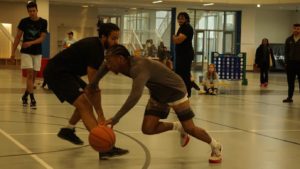Students Experience Increased Anxiety in the Classroom
March 23, 2022
College students with anxiety say that the classroom environment creates excess stress. Public speaking, large workloads, and fear of contracting COVID-19 often heighten symptoms of anxiety disorders.
According to the National Alliance of Mental Health, nearly 10 million Americans live with a serious mental disorder, and anxiety disorders are among the most common.
Although anxiety disorders are frequent among Americans and highly treatable, the Anxiety and Depression Association of America said that only 37% of those affected receive treatment.
Carley Madeia, a student at Central Connecticut State University, has an anxiety disorder and said being in the classroom spikes her symptoms.
“As someone who struggles with anxiety, the feelings when in a classroom can definitely skyrocket,” Madeia said.
The National Institute of Mental Health reported that about 12% of American adults experience a social anxiety disorder at some point, and Madeia is no different.
“It’s the constant worry that the professor is going to randomly call on me,” she said. “Or if I don’t get an answer right, will the people around me judge?”
Students with social anxiety disorder experience significant anxiety, self-consciousness, and embarrassment due to fear of being scrutinized or judged by others. Many college professors assign group work, include class presentations in their curriculum, and call on students in the classroom, which can heighten the symptoms of those affected.
Madeia said that assigned tasks like presenting in class could be “a lot” for her mental health as she often worries about how her peers and professors perceive her.
On top of the fear of public speaking, heavy workloads also increase anxiety in students. Many full-time students juggle 4-6 classes a semester, part-time jobs, and participate in clubs, leaving little time in the week to destress. CCSU has more than 100 clubs and organizations and about 8,500 full-time students.
A study by AIMS Public Health found that workload pressure was one of the risk factors associated with stress, anxiety, and depression in college students. Madeia said that large amounts of school work play a significant role in increasing her anxiety.
“When it comes to homework load, that can also be overwhelming because sometimes it feels like you’re drowning with all things school work,” she said. “Taking time for myself or even for friends and family can be hard.”
On top of stress due to their workloads, many college students also worry about COVID-19. The Journal of Medical Internet Research reported that 71% of students experienced increased stress and anxiety due to the COVID-19 outbreak.
Of those students, 91% worried about the health of themselves and their loved ones, 89% had difficulty concentrating, and 82% were concerned about their academic performance.
While her anxiety has been on the rise, Madeia said she is utilizing the counseling services at CCSU and figuring out different coping strategies. “If I do become stressed or anxious, it helps me to take steps to calm me down,” she said. “Whether that’s to listen to music, play with my cat, or watch TV.”





